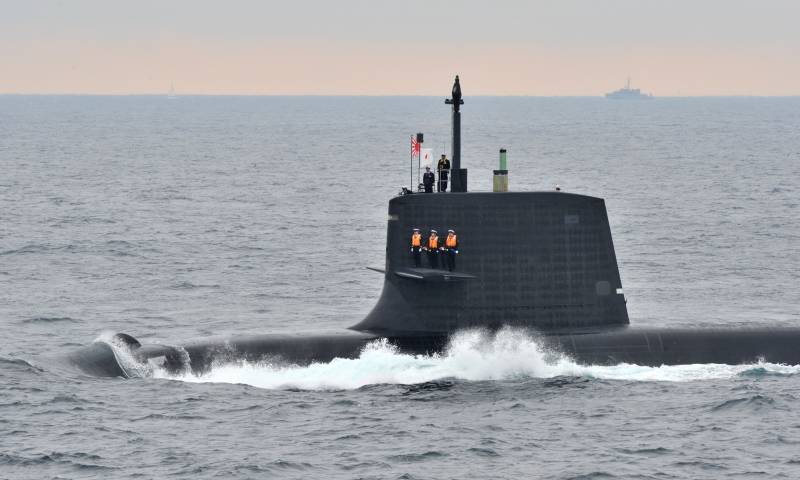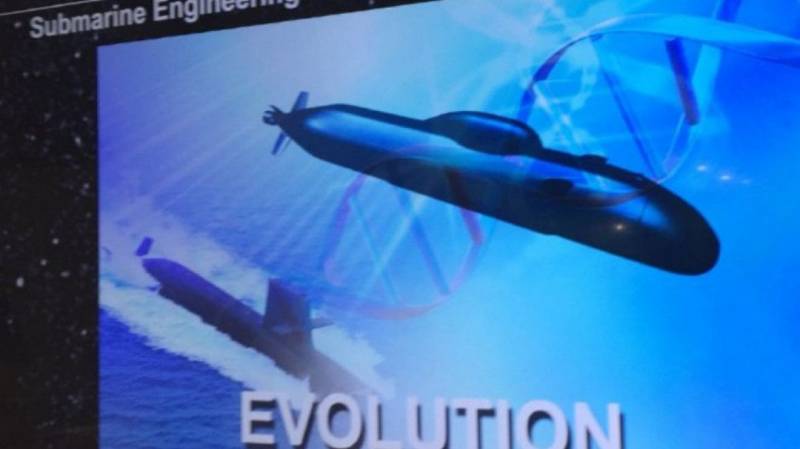Rule Japan seas! The boat of the future in the representation of "Mitsubishi"
Revival of past greatness
The Japanese fleet does not have nuclear submarines, but it has at its disposal twenty multi-purpose submarines (non-nuclear submarine), which are fully consistent with the requirements of their time. These are submarines of the Oyashio and Soryu type. The oldest of them all, the Oyashio lead ship with tail number SS-590, was commissioned fleet March 16, 1998. Against the background of some Russian and American submarines - relatively recently. The nuclear "strategist" USS Ohio (SSGN-726), recall, was put into operation in 1981, and he currently has active service.
There is another important aspect that characterizes the Japanese submarine fleet. This is a technical level. The litter submarine, in addition, has an air-independent Stirling engine. The most notorious anaerobic installation, which does won't get to Russian non-nuclear submarines. And which gives a very high (by the standards of diesel-electric boats) freedom of action.
In general, according to experts, Japanese submarines are among the most technologically advanced and dangerous for the enemy. Yes, and the Japanese fleet, in general, as shown by the chart of the organization Naval Analyzes, looks very impressive. However, this is far from the end. And it's not just the intentions of the Japanese to arm aircraft-carrying ships with fifth-generation fighters F-35B.
His Majesty's submarine
Recently, the publication Popular Mechanics drew attention to the emerging images of a promising submarine from the company Mitsubishi Heavy Industries, a member of the Mitsubishi Group. The non-nuclear submarine was named 29SS, where "29" comes from the year of Emperor Akihito's reign (namely, 2017), and SS is an international abbreviation for non-nuclear multi-purpose submarines. According to experts, purely conceptual 29SS in many ways repeats "litter", but even a quick visual inspection also shows significant differences.
The hull design was made more “futuristic”, which can be aimed at achieving the wow effect (we are talking only about images, so far), however, it is more likely intended to reduce hydrodynamic resistance. Roughly speaking, to make the submarine faster, more maneuverable and to improve autonomy in comparison with the Soryu-type submarine. And, of course, it serves to increase the key indicator for each submarine, namely, to reduce the noise level and, as a result, to increase its survivability. The chosen jet instead of the propeller serves the same purpose.
Well-known expert of the Navy H. Sutton (HI Sutton) believes that the new development should be taken as seriously as possible. However, one should not expect any revolution from 29SS. “The design of the new ship,” says the expert, “focuses on improving the concept of the submarine (apparently the Soryu type boats are meant, - Military Review) and shows that the Japanese navy will continue to move forward by building highly efficient submarines which may be the best non-nuclear submarines in the world. ”
According to experts, continuity with a boat like "Soryu" will be visible in the case of armament. The 29SS is likely to get six 533 mm torpedo tubes that can be located in the bow of the ship. Note that all the "litter" can carry up to 30 torpedoes, and instead of some of them can use anti-ship missiles UGM-84. It is also worth saying that modern German submarines of the 212A project, as well as Russian diesel-electric submarines of the 677 project, have a similar set of weapons.
Even less definitely we can talk about timing. It is known that research and development work is extended from 2025 to 2028 years, and the submarines of the “Soryu” type will replace the new boat in Japan’s Japanese Self-Defense Forces in about 2030’s. However, this is on condition that there will be no “force majeure”.
Who will we fight against?
Hardly new weapon Japanese can be directed against Russia, despite the long-standing territorial dispute. To put it mildly, he pales against the background of the old, but no less relevant, Japanese-Chinese contradictions: it suffices to recall the attitude to World War II and the actual support by the People’s Republic of China of the odious leaders of the DPRK. However, perhaps, the Japanese, with all their desire, will not be able to find an effective answer to the Chinese navy, which, we recall, quite recently surpassed the number of warships in the US Navy (it’s still too early to talk about qualitative superiority).
The Australian edition of Defense Connect has already responded to the development of 29SS, recalling the planned commissioning of twelve new multi-purpose non-nuclear submarines by the Australian fleet to ensure the safety of a distant continent.
Submarines, the type of which is named by the simple name “Attack”, will be built on the basis of the project of the French shipbuilding company Naval Group under the name of Shortfin Barracuda. New boats will replace the ships of the class Collins, which are now in operation. It is noteworthy that this program has already cost the Australian taxpayers a fantastic amount - 50 billion dollars. Approximately as much the United States of America spent on the development of F-35, so the successes of Japan in the same direction may turn for the Australian authorities, among other things, also a big scandal.



Information